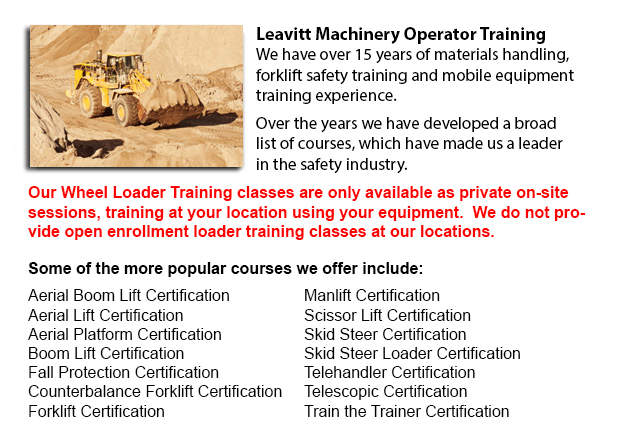
Wheel Loader Operator Training Calgary - Cranes are industrial equipment that make use of pulleys or levers to lift substantial weights. The Romans used cranes so as to construct large monuments, that means these machinery have been around for at least 2,000 years. Several Medieval churches used cranes in their creation as well as the Egyptian people may have relied on them when building the pyramids.
Modern cranes can either be simple or complex, based on the nature of the use they could carry out. For instance, mobile cranes are rather simple units. A steel truss and even a telescopic boom mounts its movable platform. A system of pulleys or levers lifts the boom and there is often a hook hanging. These cranes are frequently intended for earthmoving or demolition by changing the hook out with one more piece of device like a bucket or wrecking ball. Telescopic cranes have a series of hydraulic tubes which fit together to form the boom. These models could even be mobile.
Regular wheels, or particular wheels designed for a railroad track or caterpillar track enable these mobile booms to navigate unpaved and uneven surfaces.
Rough terrain and truck mounted cranes are mobile also. Outriggers are positioned on the truck mounted model to improve stability, while rough terrain cranes comprise a base that tends to resemble the bottom of a 4-wheel drive. These cranes are outfitted in order to operate on rough ground making them perfect in the construction industry for example.
Gantry cranes are actually utilized in order to transport and unload large containers off of ships and trains. They are normally seen functioning in ports and railroads. Their bases include huge crossbeams that run on rails to be able to lift containers from a place to another. A portainer is a unique kind of gantry which transports materials onto and off of ships specifically.
Floating cranes are mounted on barges or pontoons and are another essential piece of equipment essential to the shipping business. In view of the fact that they are located in water, they are utilized for various services including building bridges, salvaging ships and port construction. Floating cranes are capable of handling very heavy loads and containers and similar to portainers, they can likewise unload ships.
Loader cranes consist of hydraulic powered booms which are fitted onto trailers to load things onto a trailer. The jointed parts of the boom could be folded down when the machinery is not in being utilized. This particular kind of crane could be even considered telescopic in view of the fact that a section of the boom could telescope for more versatility.
Normally seen in automated warehouses, stacker cranes tend to follow an automated retrieval system and could operate utilizing a remote. These cranes are equipped along with a lift truck machinery and could be seen in large automated freezers, stacking or obtaining foodstuff. Utilizing this particular kind of system allows staff to remain out of that cold setting.
Tower cranes are often the tallest cranes and usually do not have a movable base. They must be put together piece by piece. Their base resembles a long ladder with the boom at a 90 degree angle to the base. These cranes specialize in the construction of tall structures and are often affixed to the inside of the building itself during the construction period.
-
Scissor Lift Ticket Calgary
Scissor Lift Ticket Calgary - The scissor forklift has been a great advantage to many companies as the effort and manpower to run one of these equipment is very minimum. In addition, many workplace injuries have been prevented by having one of these... More -
Aerial Lift, Boom Lift, Man Lift, Scissor Lift Training in Calgary
Lift tables or also referred to as scissor hoists can raise both people and supplies vertically. They are most often utilized in commercial, industrial and construction environments. Commonly, the use of a scissor lift is to lift and lower materials... More -
Telehandler Training Courses Calgary
Telehandler Training Courses Calgary - Employers are responsible for ensuring that their operating personnel and supervisors are trained to work proficiently utilizing telehandler machinery. The competence level of employees need to be assessed. If d... More -
Crane License Calgary
Crane License Calgary - Crane operators should be "credentialed", that means they must possess a crane operator license or certification. Credentialing is considered a mandatory governmental requirement in order to practice as a crane operator. Licen... More -
Forklift License Calgary
Forklift License Calgary - Within North America, acquiring a forklift license or forklift certification involves classroom and hands-on training. Regulatory control over licensing, certification and training for powered industrial truck operators fal... More -
Forklift Train The Trainer Calgary
Forklift Train The Trainer Calgary - Our business provides the latest and most advanced Forklift Training courses within North America. We provide Train the Trainer, mobile equipment operator, industrial workplace safety training, and self study trai... More -
Crane Training Courses Calgary
Crane Training Courses Calgary - The heavy machine crane is designed to lower, move and lift heavy stuff. Normally, the crane comes outfitted together with sheaves, a hoist, and chains or wire ropes. Cranes are used in the construction, transport and... More -
Manlift Safety Training Calgary
Manlift Safety Training Calgary - It is vital for skilled Manlift operators to be aware of the associated dangers which come with specific models of scissor lifts. They should be able to operate the scissor lift in a way that protects not just their... More

Forklift Training Calgary
TOLL FREE: 1-888-254-6157
Calgary, Alberta
forklifttrainingcalgary.com
Email Us
About Us



